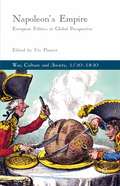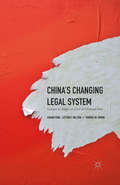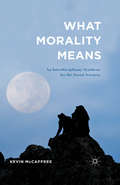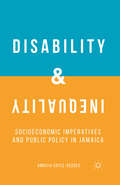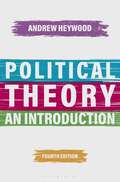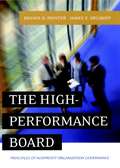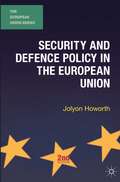- Table View
- List View
Napoleon's Empire: European Politics in Global Perspective (War, Culture and Society, 1750-1850)
by Ute Planert Frank BlackabyThe Napoleonic Empire played a crucial role in reshaping global landscapes and in realigning international power structures on a worldwide scale. When Napoleon died, the map of many areas had completely changed, making room for Russia's ascendency and Britain's rise to world power.
Women's Bodies as Battlefield: Christian Theology and the Global War on Women
by Susan Brooks ThistlethwaiteChristian theology has been complicit in justifying the war on women, but it also has resources to help finally declare peace in the war on women. War itself has come to resemble the war on women, and thus strategies to end the war on women, supported by new Christian theological interpretations, will also help end today's endless wars.
Threats to Homeland Security: Reassessing the All-Hazards Perspective
by Richard J. KilroyAddresses threats to homeland security from terrorism and emergency management from natural disasters Threats to Homeland Security, Second Edition examines the foundations of today's security environment, from broader national security perspectives to specific homeland security interests and concerns. It covers what we protect, how we protect it, and what we protect it from. In addition, the book examines threats from both an international perspective (state vs non-state actors as well as kinds of threat capabilities—from cyber-terrorism to weapons of mass destruction) and from a national perspective (sources of domestic terrorism and future technological challenges, due to globalization and an increasingly interconnected world). This new edition of Threats to Homeland Security updates previous chapters and provides new chapters focusing on new threats to homeland security today, such as the growing nexus between crime and terrorism, domestic and international intelligence collection, critical infrastructure and technology, and homeland security planning and resources—as well as the need to reassess the all-hazards dimension of homeland security from a resource and management perspective. Features new chapters on homeland security intelligence, crime and domestic terrorism, critical infrastructure protection, and resource management Provides a broader context for assessing threats to homeland security from the all-hazards perspective, to include terrorism and natural disasters Examines potential targets at home and abroad Includes a comprehensive overview of U.S. policy, strategy, and technologies for preventing and countering terrorism Includes self-assessment areas, key terms, summary questions, and application exercises. On-line content includes PPT lessons for each chapter and a solutions key for academic adopters Threats to Homeland Security, Second Edition is an excellent introductory text on homeland security for educators, as well as a good source of training for professionals in a number of homeland security-related disciplines.
European Union Politics (Macmillan Foundations Series)
by John McCormickThis 2nd edition of this best-selling introductory and student-friendly text provides an engaging introduction to all aspects of politics and policy in the European Union. Esteemed textbook author John McCormick introduces the unique nature of EU politics, whilst analysing the Union’s impact upon the meaning of Europe and the lives of Europeans. This second edition has been updated throughout - taking account of the 2014 European Parliament elections and changes to key roles in the EU - and has additional coverage of theoretical approaches used to study the EU that will encourage students towards a more sophisticated understanding of how and why the EU has become what it is today, of its strengths and weaknesses and of the on-going crisis in the Eurozone. McCormick has designed this textbook to be accessible to students of all backgrounds and abilities, to act as a companion throughout their studies. Breakdowns of key concepts and debates, numerous case studies, chapter summaries, photos, and more are all included to aid learning. This has all been complimented by a companion website, full of self-test Q & A's, updated material, and lecturer resources to aid teaching and learning, making this text a true essential for all those teaching and studying the EU.
China's Changing Legal System: Lawyers & Judges on Civil & Criminal Law
by Thomas W. Simon Chuan Feng Leyton P. NelsonWhile much international attention has been focused on China's developing economy, dramatic changes are also taking place in its legal system. This book is a groundbreaking, comprehensive introduction to China's legal system, covering the major areas of both civil and criminal law. The authors present fascinating cases and balanced accounts of controversial issues, from copyright law to punishment. By letting Chinese lawyers and judges speak for themselves, the authors also allow readers a surprisingly candid insider's view of real life legal practice.
What Morality Means: An Interdisciplinary Synthesis for the Social Sciences
by Kevin McCaffreeWhat Morality Means examines the scientific theory of morality, drawing on zoological and physiological literatures in addition to contemporary sociological research on status and exchange. The theory roots morality in the capacity for perceptual overlap, and describes how perceptual overlap has been constrained and enabled in human history.
Disability and Inequality: Socioeconomic Imperatives and Public Policy in Jamaica
by A. Gayle-GeddesDisability and Inequality:Socioeconomic Imperatives and Public Policy in Jamaica explores the lived experiences of persons with disabilities (PWDs) in Jamaica, examining measurable socioeconomic deficits that establish PWDs are more likely to experience inferior education, training, and labor market outcomes compared to persons without disabilities. The author provides an evidence-based, theoretically grounded, and implementable public policy framework, called Framework of Key Determinants for Political and Socioeconomic Inclusion of PWDs, which advances anti-discrimination legislation and a twin-track policy schema with interconnected enablers of human rights. Using this framework, Jamaica, the Caribbean, and other Southern countries looking for methods and strategies to fulfill commitments set out by the United Nations' Convention on the Rights of Persons with Disabilities will find approaches to sustain existing progress, and address structural systemic deficits which continue to deny PWDs long-term sustainable development.
Elizabeth I's Foreign Correspondence: Letters, Rhetoric, and Politics (Queenship and Power)
by J. Gibson C. Bajetta G. CoatalenThough Elizabeth I never left England, she wrote extensively to correspondents abroad, and these letters were of central importance to the politics of the period. This volume presents the findings of a major international research project on this correspondence, including newly edited translations of 15 of Elizabeth's letters in foreign languages.
Understanding, Assessing, and Responding to Terrorism: Protecting Critical Infrastructure and Personnel
by Brian T. BennettA comprehensive guide to understanding, assessing, and responding to terrorism in this modern age This book provides readers with a thorough understanding of the types of attacks that may be perpetrated, and how to identify potential targets, conduct a meaningful vulnerability analysis, and apply protective measures to secure personnel and facilities. The new edition of Understanding, Assessing, and Responding to Terrorism updates existing material and includes several new topics that have emerged, including information on new international terrorist groups as well as a new chapter on Regulations and Standards. A vulnerability analysis methodology, consisting of several steps—which include the techniques necessary to conduct a vulnerability analysis—is introduced and applied through several sample scenarios. By using easily customized templates for the screening process, valuation of a critical asset as a target, vulnerability analysis, security procedures, emergency response procedures, and training programs, the book offers a practical step-by-step process to help reduce risk. Each different type of terrorism is briefly discussed—however, the book focuses on those potential attacks that may involve weapons of mass destruction. There is a discussion of what physical and administrative enhancements can be implemented to improve a facility's ability to devalue, detect, deter, deny, delay, defend, respond, and recover to a real or threatened terrorist attack—whether it be at a facility, or in the community. Techniques on how personnel safety and security can be improved through the implementation of counter-terrorism programs are also outlined. An overview of the major counter-terrorism regulations and standards are presented, along with the significant governmental efforts that have been implemented to help prevent terrorist attacks and foster preparedness at both private and public sector facilities and for personnel. Understanding, Assessing, and Responding to Terrorism, Second Edition: Updates existing material, plus includes several new topics that have emerged including information on new international terrorist groups, new terrorist tactics, cyber terrorism, and Regulations and Standards Outlines techniques for improving facility and personnel safety and security through the implementation of counter-terrorism programs Unites the emergency response/public sector community with the private sector over infrastructure protection, thus allowing for easier communication between them Includes questions/exercises at the end of each chapter and a solutions manual to facilitate its use as a textbook Understanding, Assessing, and Responding to Terrorism, Second Edition is a must-have reference for private and public sector risk managers, safety engineers, security professionals, facility managers, emergency responders, and others charged with protecting facilities and personnel from all types of hazards (accidental, intentional, and natural).
Governance and Politics of China (Comparative Government and Politics)
by Tony SaichThe success or failure of China's development will impact not only its own citizens but also those of the world. China is widely recognized as a global actor on the world stage and no global challenge can be resolved without its participation. Thus, it is important to understand how the country is ruled and what the policy priorities are of the new leadership. Can China move to a more market-based economy, while controlling environmental degradation? Can it integrate hundreds of millions of new migrants into the urban landscape? The tensions between communist and capitalist identities continue to divide society as China searches for a path to modernization. The People's Republic is now over sixty-five years old – an appropriate juncture at which to reassess the state of contemporary Chinese politics. In this substantially revised fourth edition and essential guide to the subject, Tony Saich delivers a thorough introduction to all aspects of politics and governance in post-Mao China, taking full account of the changes of the Eighteenth Party Congress and the Twelfth National People's Congress. Further, the rise of Xi Jinping to power and his policies are examined as are important policy areas such as urbanization and the fight against corruption.
Technology and Emergency Management
by John C. PineThe first book devoted to a critically important aspect of disaster planning, management, and mitigation Technology and Emergency Management, Second Edition describes best practices for technology use in emergency planning, response, recovery, and mitigation. It also describes the key elements that must be in place for technology to enhance the emergency management process. The tools, resources, and strategies discussed have been applied by organizations worldwide tasked with planning for and managing every variety of natural and man-made hazard and disaster. Illustrative case studies based on their experiences appear throughout the book. This new addition of the critically acclaimed guide has been fully updated and expanded to reflect significant developments occurring in the field over the past decade. It features in-depth coverage of major advances in GIS technologies, including the development of mapping tools and high-resolution remote sensing imaging. Also covered is the increase in computer processing power and mobility and enhanced analytical capabilities for assessing the present conditions of natural systems and extrapolating from them to create accurate models of potential crisis conditions. This second edition also features a new section on cybersecurity and a new chapter on social media and disaster preparedness, response, and recovery has been added. Explores the role of technology in emergency planning, response, recovery, and mitigation efforts Explores applications of the Internet, telecommunications, and networks to emergency management, as well as geospatial technologies and their applications Reviews the elements of hazard models and the relative strengths and weaknesses of modeling programs Describes techniques for developing hazard prediction models using direct and remote sensing data Includes test questions for each chapter, and a solutions manual and PowerPoint slides are available on a companion website Technology and Emergency Management, Second Edition is a valuable working resource for practicing emergency managers and an excellent supplementary text for undergraduate and graduate students in emergency management and disaster management programs, urban and regional planning, and related fields.
Governance and Politics of the Netherlands (Comparative Government and Politics)
by Rudy B. Andeweg Galen A. IrwinThe fourth edition of this leading text provides again a clear and comprehensive account of politics in the Netherlands. It has been revised and updated throughout to provide full coverage of recent developments and events - and, in particular, examines the challenges to the distinctively Dutch quest for consensus.
Political Theory: An Introduction
by Andrew HeywoodThis leading text provides a concise and broad-ranging introduction to the contemporary study of political theory. Each chapter discusses a cluster of interrelated concepts and examines how they have been used by different thinkers and traditions and explores related debates and controversies. The fourth edition of this highly successful and accessible book has been substantially revised and updated and includes extra attention throughout to non-Western approaches and international political theory.Systematically covering the foundational concepts that have focused debate from Aristotle, Rousseau, Marx and Mill to the present day, this is essential reading for undergraduate and postgraduate courses on political thought and political philosophy. With increased discussion of the global dimensions of political thought it will appeal to an international audience, as well as to those lecturers interested in broadening their students’ horizons.
Comparative Approaches to Program Planning
by F. Ellen Netting Mary Katherine O'Connor David P. Fauri"As a practitioner in the field for over thirty years, I have been exposed to endless 'planning' sessions that are prescriptive to the point of being oppressive. Thistext 'gives permission' to the practitioner to allow for emergence, uncertainty, and ambiguity in the planning process. Comparative Approaches to Program Planning provides a guide for the manager, administrator, executive director, strategic planner, and CEO to embrace multiple planning strategies and the understanding of each. This is extremely worthwhile in a dynamic environment and an ever- changing landscape and worldview."—Paul D. McWhinney, ACSW, Director of Social Services City of Richmond, Richmond, Virginia "This is the book I've been waiting for. It provides not only a linear approach to program design, but gives language to the tacit knowledge many planners have of the circular nature of their work. Both linear and circular thinking are important to planning processes and now we have a resource for teaching."—Jon E. Singletary, PhD, MSW, MDiv, Baylor University, School of Social Work The first text on program planning to guide readers in selecting program planning approaches appropriate to setting, culture, and context Valuable for students and practitioners in the social work, public administration, nonprofit management, and community psychology fields, Comparative Approaches to Program Planning provides practical and creative ways to effectively conduct program planning within human service organizations. Written by leaders in the social work education community, this innovative book explores program planning as a multi-layered and complex process. It examines both a traditional linear problem-solving model as well as an alternative emergent approach to program planning, helping professionals to successfully develop and enact effective and culturally competent planning in organizations and communities.
The High-Performance Board: Principles of Nonprofit Organization Governance (The\jossey-bass Nonprofit And Public Management Ser.)
by Dennis D. Pointer James E. OrlikoffWhile boards acknowledge they bear ultimate responsibility and accountability for their organizations' affairs, governance quality is often far from optimal. The High- Performance Board offers pragmatic and candid advice about what your board must do to maximize performance and contributions. The authors provide sixty-four principles designed to help your board achieve peak performance. They describe every principle in detail and present best practices and practical applications for each one. Each section of the book concludes with a board check-up-a set of questions that can be used to assess your board in light of the principles. A quick read for busy board members, this book is the ultimate board "drivers' manual."
Europe Recast: A History of European Union (The European Union Series)
by Desmond DinanThis is the fully updated 2nd edition of the leading textbook on the history and evolution of the European Union, written by a leading authority, and highly successful textbook author, in a clear, entertaining and accessible style. Dinan tells the story of European integration from its modern origins in the 1940s to the challenges of the Eurozone crisis. Organized chronologically with each chapter broadly covering a decade, a thematic introduction and concluding chapter draw out key issues and themes and assess rival interpretations. Dinan begins at the EU's modern origins post-WWII, through its gradual enlargement, to the recent challenges of the Eurozone crisis and Euroscepticism. This is a comprehensive introduction to the underlying ideals, political dynamics, economic forces, and personal efforts that shaped the original European Communities and how that led to the development of the EU today. Particular historical interpretations are analysed impartially by evaluating the main theories in turn, and offering the author’s own analysis. New material on the historiography informs students how to navigate historical interpretations and conduct their own research. This textbook assumes no underlying knowledge, and aims to be accessible to students of various disciplines. The text is written clearly, with minimal jargon and abbreviations, and includes extra resources such as timelines and relevant lists. The book is an essential introductory text for students of the EU, as well as companion for all students continuing further in their studies.
The American Myth of Markets in Social Policy: Ideological Roots of Inequality
by Debra HevenstoneThe American Myth of Markets in Social Policy examines how implementing American tropes in policy design inadvertently frustrates policy goals. The book investigates multiple market-oriented designs including funding for private organizations to deliver public services, funding for individuals to buy services, and policies incentivizing or mandating private actors to provide social policy. Hevenstone shows that these solutions often not only fail to achieve social goals, but actively undermine them. The book carefully details the mechanisms through which this occurs, and examines several policies in depth, covering universal social insurance programs like healthcare and pensions, as well as smaller interventions like programs for the homeless.
Nuclear Power and Energy Policy: The Limits to Governance
by Keith Baker Gerry StokerThis book explores how different governments have leveraged their capacity to advance a revival of nuclear power. Presenting in-depth case studies of France, Finland, Britain and the United States, Baker and Stoker argue that governments may struggle to promote new investment in nuclear power.
The Political Geography of Campaign Finance: Fundraising and Contribution Patterns in Presidential Elections, 2004–2012
by Andrew Dowdle Scott Limbocker Karen Sebold Patrick A. Stewart Joshua L. MitchellThe Political Geography of Campaign Finance examines the distribution of political campaign contributions in the 2004, 2008, and 2012 preprimary election periods. Using aggregated individual level data, the authors determine if certain areas contribute more to presidential candidates in different stages of the campaign, and if these patterns are independent of wealth and partisanship. Unlike previous research, this book examines individual counties over multiple election cycles.
Colorblindness, Post-raciality, and Whiteness in the United States
by Sherrow O. PinderThis book problematizes the ways in which the discourses of colorblindness and post-raciality are articulated in the age of Obama. Pinder debunks the myth that race does not matter and reconsiders the presumptive hegemony of whiteness through the dialectics of visibility and invisibility of race.
The New Health Bioeconomy: R&D Policy and Innovation for the Twenty-First Century
by James MittraThis book provides new insights into how new biology, and the emergence of "translational" policies to drive the health bioeconomy, is reshaping the innovation ecosystem for new therapies. A key argument is that a broader definition of value (beyond the economic aspects) is needed to understand health innovation in the twenty-first century.
Extreme Events: Observations, Modeling, and Economics (Geophysical Monograph Series #214)
by Mario Chavez Michael Ghil Jaime Urrutia–FucugauchiThe monograph covers the fundamentals and the consequences of extreme geophysical phenomena like asteroid impacts, climatic change, earthquakes, tsunamis, hurricanes, landslides, volcanic eruptions, flooding, and space weather. This monograph also addresses their associated, local and worldwide socio-economic impacts. The understanding and modeling of these phenomena is critical to the development of timely worldwide strategies for the prediction of natural and anthropogenic extreme events, in order to mitigate their adverse consequences. This monograph is unique in as much as it is dedicated to recent theoretical, numerical and empirical developments that aim to improve: (i) the understanding, modeling and prediction of extreme events in the geosciences, and, (ii) the quantitative evaluation of their economic consequences. The emphasis is on coupled, integrative assessment of the physical phenomena and their socio-economic impacts. With its overarching theme, Extreme Events: Observations, Modeling and Economics will be relevant to and become an important tool for researchers and practitioners in the fields of hazard and risk analysis in general, as well as to those with a special interest in climate change, atmospheric and oceanic sciences, seismo-tectonics, hydrology, and space weather.
Security and Defence Policy in the European Union (The European Union Series)
by Jolyon HoworthThe Common Security and Defence Policy (CSDP) has come a long way since its inception as the European Security and Defence Identity under NATO. Yet more than a decade after emerging as an autonomous entity, with its own capacity for civilian crisis management and military action, the European Union's CSDP is still very much a work in progress. This fully revised and updated new edition provides the most comprehensive account available of the CSDP and the debates surrounding it. Written by a leading authority in the field, the second edition draws on the author's own extensive research in the area, including hundreds of interviews with key actors, and takes account of developments since the reforms of the Lisbon Treaty. A brand new chapter assesses international relations theory and European integration theory as tools to understand the CSDP, and critically engages with theoretical approaches that view security and defence policy as the exclusive domain of sovereign nation-states. The book concludes with an analysis of future hurdles for the European Union as it responds to new and often unpredictable crises across the globe.
Urban Planning: An Introduction (Planning, Environment, Cities)
by Chris CouchThis is a wide-ranging and internationally-focussed introduction to planning for the urban landscape. It provides an up-to-date account of planning, reflecting throughout on the need for sustainable, efficient and equitable solutions to planning problems. Taking account of the sometimes conflicting expectations of markets, citizens, public organizations and planners, it demonstrates the similarities of challenges faced in different national planning systems.The author traces the historical evolution of planning and urban governance, and explores the range of urban problems and policies likely to be found in almost any city in the developed world. Combining the latest theory in the field with practical insight and numerous illustrative case studies, the author comprehensively addresses issues of economic change and development; retailing and the role of urban centres; housing provision and neighbourhood renewal; urban design and conservation; green and blue infrastructure; and mobility and accessibility. Assuming no prior knowledge of the subject, this text is the ideal accessible introduction to the planning field, giving equal focus to both theory and practice. Whilst celebrating the work of planners, it also provides essential critical analysis of how key decisions are made and implemented, the benefits and limitations of planning, and ultimately its potential in achieving 'good city form'.
The European Union: What it is and how it works (The European Union Series)
by Ingeborg ToemmelThe European Union affects the lives of Europeans in many and varied ways, yet, in spite of its reach, it often appears a constrained political system – struggling for internal consensus, reliant on the agreement of national governments, and hampered by the scepticism of electorates. These issues have become even more acute in the wake of the global economic and eurozone crises. This new text provides a concise and up-to-date introduction to the nature of the European Union, giving an account of its evolution and structure that makes sense of its current challenges. The text analyses the EU's institutional structure and decision-making procedures, and highlights the manifold conflicts as well as the sophisticated mechanisms for consensus-building among the core institutions. It explains the ways in which the EU differs from other forms of political order, and how this leads to political processes that are characterized by cooperation and conflict. In providing this context, the author invites readers to a critical assessment of the functioning of the European Union, and of the implications of this for its democratic legitimacy and future prospects.
